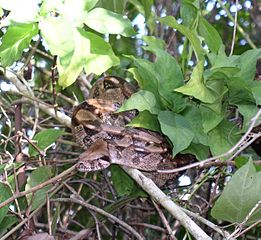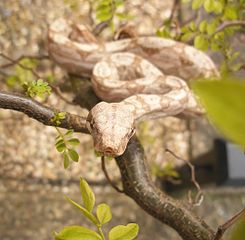Despite decades in the pet trade, the Boa Constrictor (Boa constrictor) remains one of the most popular of all reptilian pets. Unfortunately, the average Boa grows too large for many households, and cannot be safely handled by young or inexperienced keepers. A number of smaller relatives, such as the Rosy, Rubber and Sand Boas, are available in the trade, along with some of the “dwarf species (Bimini and Panamanian Dwarf Boas). However, for the true Boa Constrictor enthusiast, they do not “fit the bill”.
Fortunately, a number of dedicated snake breeders have focused on the unique populations of smaller Boa Constrictors that inhabit many Caribbean islands. Averaging only 4-5 feet when fully grown, these beautiful creatures are ideal choices for those seeking a large, but not giant, snake. More importantly, island-bound Boas offer hobbyists the chance to dabble in snake conservation. As all are restricted to tiny ranges, everything that we learn will be helpful in assuring their future survival.
Classification
Boa taxonomy and terminology has always been a “work in progress” (to say the least!). Most of the island-dwelling snakes I’ll mention below are believed to belong to the Boa Constrictor subspecies Boa constrictor imperator (please see photo). Generally termed the Common or Northern Boa Constrictor, B. constrictor imperator ranges from Mexico to northern South America and has long been a pet trade staple.
An Important Note for Boa Keepers
Unfortunately, some owners cross the various island-dwelling boas with mainland boas, altering their colors and adult sizes. This practice should be discouraged, as these snakes have been isolated for millions of years, and possess unique genetic makeups. Be sure to check into the backgrounds of any snakes that you intend to purchase. Purebred individuals will be expensive, but they are very important to the futures of these unique, fragile populations.
Hog Island Boa
I’ll start off with the only member of the group that has the sad distinction of being possibly extinct in the wild. This 5-foot-long snake is also rather unique in being able to change its color, sometimes quite radically.
Hog Island Boas (please see photo) hail from Cayo Cochinos, a small archipelago off Honduras. Buff to off-white in color, and marked with faded saddles and pinkish hues, they are spectacular in appearance.
Caulker’s Cay Boa
Among the smallest and lightest in color of the island-dwelling Boa Constrictors, this snake faces an uncertain future. Its only habitat is a coral island measuring a mere 5 x .9 miles. Located just off Belize, Cay Caulker is also a popular tourist destination. This unique animal deserves more attention from breeders.
Corn Island Boa
Native to 2 small islands off Nicaragua’s Caribbean coast, Corn Island Boas are quite rare in captivity and the wild. They vary greatly in background color, with lighter individuals often tinged in pink.
Crawl Cay Boa
This boa, native to a small island group near Belize’s east coast, feeds largely upon birds and lizards. Youngsters usually take lizard-scented mice, and can be induced to take unscented rodents in time. Crawl Cay Boas are greyish in color and heavily speckled with black. They top out at five feet in length.
Pearl Island Boa
Unlike the snakes I’ve mentioned above, this small boa has been granted subspecies status (B. constrictor sabogae) and is not native to a Caribbean island. It inhabits Sabogae, Pearl, San Jose and nearly islets in the Gulf of Panama. Threatened by development (please see photo), it has disappeared from much of its range, and is possibly the rarest and most expensive Boa Constrictor in the trade.
Housing
The care of smaller boas generally follows that of the more commonly-kept mainland animals. I’ll summarize here…please see this article and post any questions below for further details.
Setting up the Terrarium
Hatchlings may be started-off in 10 gallon aquariums. Small adults might be accommodated in a 75 gallon aquarium, but custom-built cages are preferable. Screen tops must be secured with clips.
A hide box should always be available.
Substrate
Newspapers and washable terrarium liners may be used as substrates for terrestrial boas. Cypress chips are attractive, but can lodge in the mouth. Therefore, it’s best to move your snakes to bare-bottomed enclosures at feeding time.
Light
Boas do not require UVB light, but may benefit from the provision of a UVA bulb.
Heat
The ambient temperature should range from 78-86 F. Incandescent bulbs can be used to create a basking site of 90-95 F. Ceramic heaters or red/black reptile night bulbs may be employed to provide heat after dark. If needed, under-tank heaters can be used to further warm the basking surface.
Provide your snake with the largest home possible, so that a thermal gradient (areas of different temperatures) can be established. Thermal gradients, critical to good health, allow reptiles to regulate their body temperature by moving between hot and cooler areas.
Feeding
Most accept pre-killed mice and rats. Youngsters often prefer lizards and frogs, but rubbing a natural prey item over a rodent will often induce feeding.
Water should always be available. Bowls should be filled to a point where they will not overflow when the snake curls up within.
Further Reading
 That Reptile Blog – Reptile, Amphibian and Exotic Pet Care and Information
That Reptile Blog – Reptile, Amphibian and Exotic Pet Care and Information






Excellent info Frank. I was told once that the disposition of these island boas generally left a little to be desired. I’ve had a few Hog Island boas and they seemed to be fine if not just a little more sensitive. How would you classify the temperament of these island boas? Also, would you think that temperament, if less than great, could be altered with further captive breeding.
Thanks
Steve Schindler
Thanks, Steve,
They seem to vary as we see in mainland boas, in my experience. Captive breeding seems to help..perhaps calmer animals adjust better, and therefore are more likely to breed; in any event, captive born individuals are almost always easier to work with. Best, Frank
Fantastic information. I’ve bookmarked this page. I especially like the comment you made about discouraging the practice of cross breeding.
Much appreciated, David.
Best regards, Frank
Hi Frank I have to ask something about my baby boa eats good and shedded once in reptile shop and once at home since I got him but why no poo I heard that boas sometimes hold but is this normal thanks for reading regard Sindy
Hi Sindy,
They vary a great deal as to timing…please send me some info as to how often it eats, how much it has eaten since you’ve had him, and the temperature of your terrarium.
Thanks, best, Frank